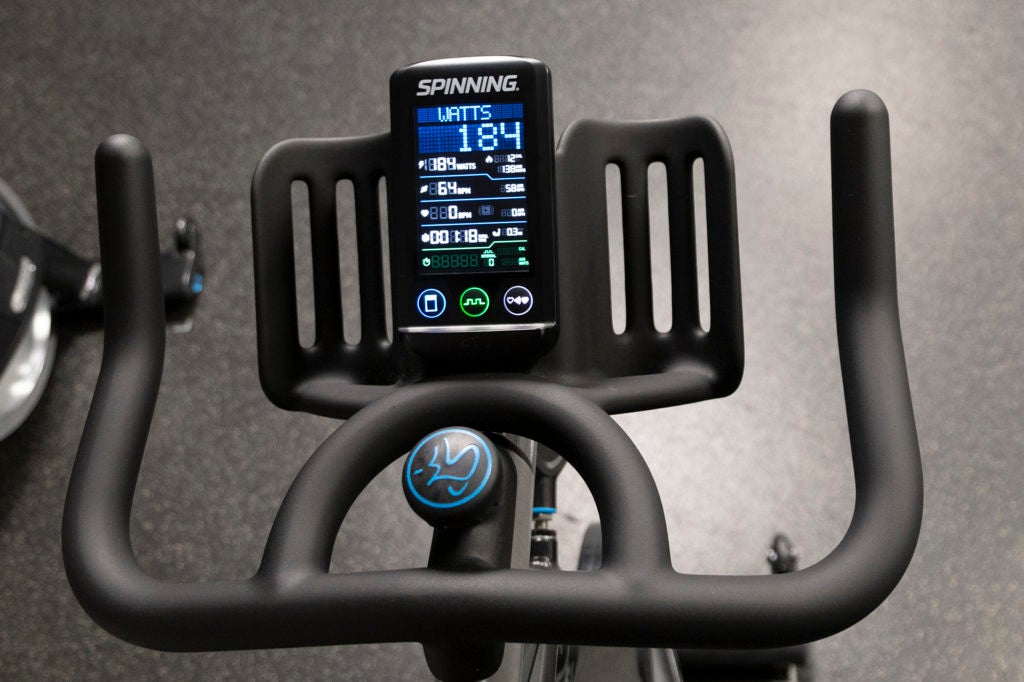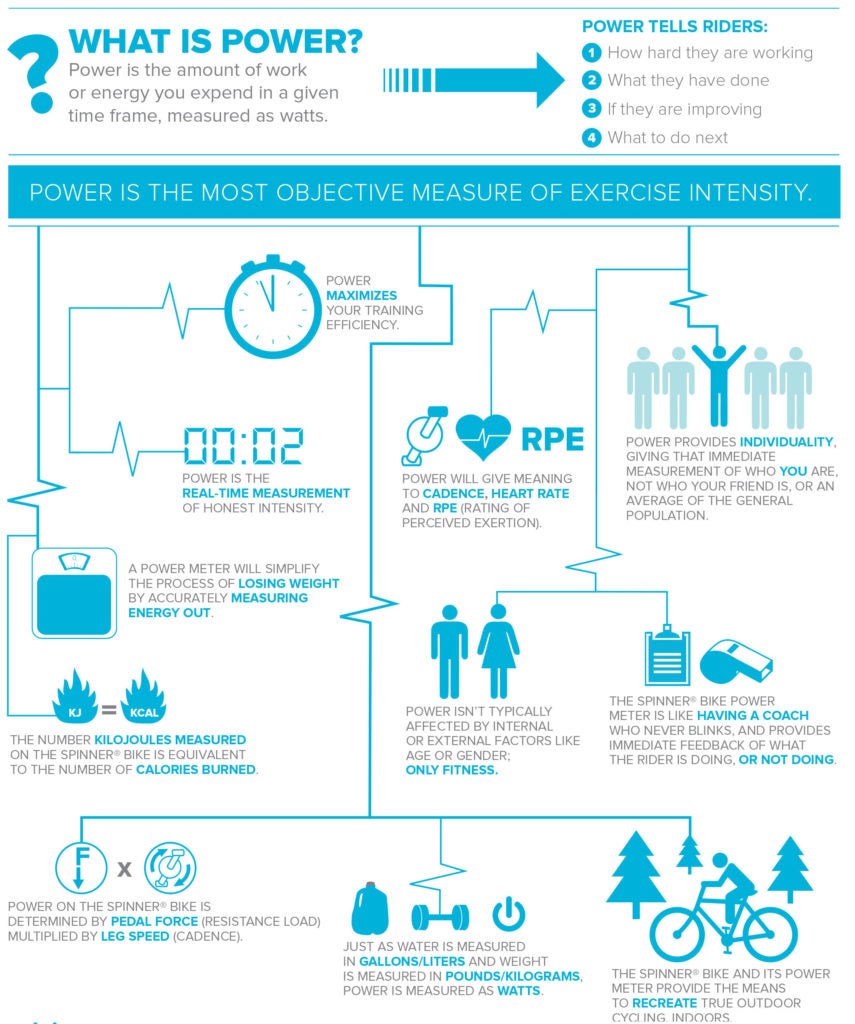We’ve Got Gadgets and Gizmos Aplenty
Posted in Announcements Blog Fitness Fitness & Wellness Corner News Special Events
By Christie L. Simoson, Assistant Fitness Director
March Fitness & Wellness Corner

We’ve had our new Spinner® Chrono™ Power bikes for a full semester now, and we want to give you the rundown about what their capability is. Apart from their shiny new presentation – there is really quite a bit more to them than meets the eye.
Not only do these bikes have all of the same readings/logistics our old ones had, but we can now add power into the mix. The Spinner® Chrono™ Power bike’s predecessor, the Spinner® Rally™, allowed us to hook up a heart rate monitor to the console to see how fast our heart was beating, which indicated how hard our cardiorespiratory system was working. These new bikes truly take it to the next level by offering the component of power. You see, while heart rate is a great tool when measuring one’s intensity, power is the direct measurement of the effort, and heart rate gives feedback about that effort. Power gives meaning to those other measurements (heart rate, cadence, and rating of perceived exertion). Put these readings together, and we have a match made in heaven!
The Spinner® Chrono™ bikes are the most accurate direct power-measurement system on the market and it comes with a state-of-the-art console; they truly set us ahead of the pack, offering power meter technology for instructors, and a smooth and authentic feel for riders. These bikes allow instructors and riders to validate that the resistance being applied to the flywheel is forcing the appropriate workload needed to build strength. In other words, this bike allows us (both instructors and participants) to hold ourselves accountable by measuring our work effort through watts. Regardless of one’s age, gender, fitness level, or athletic status, measuring work effort is key to reaching fitness and performance goals!
To help explain just how special these bikes are, let’s dive a bit deeper into what power is, and how it can actually assist in better training. Power is defined as “the amount of work or energy you expend in a given timeframe, measured as watts” (Sturtevant, 2017). While the typical formula for power is Force (F) x Velocity (V), we would like to break it down into terminology in which we can relate it to a Spinning bike: Power = Pedal Force (resistance load) x Leg Speed (cadence). This means that the wattage we see at the top of our screen while on our bikes is the result of multiplying how fast we are pedaling by our resistance (how hard it is to turn the pedals). This number provides us with an accurate measurement of the amount of force applied by the rider and the rate at which they apply the force to move the bike a certain ‘distance’.
Below is a spectacular graphic which will give you the rundown of Power:

Power allows us to maximize our training efficiency, giving us a real-time measurement of honest intensity. As stated earlier, power provides us with individuality, informing us of where we are as individuals regardless of demographics, where your neighbor is, or where the general population is.
Another exciting benefit of these new bikes is that it brings forth the opportunity to offer individuals a unique way to measure their Power Spin Threshold (PST). The PST test represents the highest level of exertion a Spinning participant can maintain before entering what is called anaerobic metabolism on a bike (Sturtevant, 2017). In other words, this test will allow you to discover your individual work rate while gaining knowledge about your power output. By completing this PST Ramp Test, you will be able to determine your endurance performance while experiencing what it feels like to reach your maximal effort in a safe and effective manner. Once finding your PST, then you can apply this knowledge for increased accountability and future rides at Yates!
How does the PST Ramp Test work?
This test is completed by following a graded ramp process, starting at a very low workload and progressively increasing effort at ramped stages. Each stage is 2 minutes and are to be completed at a steady cadence of 70-90 revolutions per minute (rpm). The intensity will then increase over time until the workload is no longer sustainable, predicting endurance performance (Sturtevant, 2017).
Will Yates ever offer PST Ramp Tests to members?
YES! Below are dates we are hosting Ramp Tests for FREE:
- Tuesday, February 18, 2020 from 11 am – 11:45 am – Studio B
- Wednesday, February 19, 2020 from 5:00 pm – 5:45 pm – Studio B
- Thursday, February 20, 2020 from 5:15 pm – 6:00 pm – Studio B
- Friday, February 21, 2020 from 4:30 pm – 5:15 pm – Studio B
Check out our RAMP Tests Facebook Event for more information!
How do I prepare for the RAMP Test?
- Get adequate sleep of eight hours or more the night before the assessment.
- Do not perform the test if you are suffering from illness, injuries or related health concerns.
- Drink plenty of fluid 24 hours prior to your assessment. Bring water for the Race Day event.
- Do not perform high-intensity training the day before or on the day of your test.
- Take medications as you would normally.
What can we do with this information once we complete the RAMP Test?
- Use your result to train power! When you hear a Spinning Power Instructor indicate a certain ‘zone’ when taking a class, you will now have these percentages of your PST to hold yourself accountable and get into the zone indicated through honest wattage.
- Use it as a benchmark! As fitness level and pedaling efficiency increase over time, repeated future tests will naturally occur at higher, more consistent cadence and increased wattage (Sturtevant, 2017)!
- Attend our RACE DAY! – This will be the equivalent of a cyclist’s time trial. You will be able to challenge your body and celebrate your strength with a ride that applies all of your training for a peak performance effort.
When is Yates hosting a Race Day?
Saturday, March 21, 2020 in Studio B from 1:00 pm – 2:00 pm!
Check out our Race Day Facebook Event for more information!
Is there anything special I should know about Race Day?
Yes! One MUST attend a PST Ramp Test in order to participate! After our last Ramp Test offering on February 21, 2020, all the names of the individuals who attended a RAMP Test will be entered into a lottery. We will then randomly draw 20 lucky names, notifying them via email that they have been chosen to attend the Race Day event on Saturday, March 21, 2020! If chosen, you should prepare for the Race Day event just as you would for a PST Ramp Test (see preparation guidelines above).
The Race Day Energy Zone is one of the most energizing! Below is a brief summary of Race Day characteristics (Sturtevant, 2017):
- Heart Rate: you will work at 80% of your maximum heart rate. Resistance can range from intense climbs to challenging flats.
- Cadence: 80-110 revolutions per minute (rpm)
What are some benefits to working in the Race Day Energy Zone?
- The Race Day Energy Zone training challenges your body to work at high heart rates, close to and above lactate threshold (LT). Lactate threshold marks the point where lactate accumulates in the bloodstream faster than it can be removed. Purposely taking your body to this point—and beyond—forces it to adapt to greater concentrations of lactate, which will dramatically improve your LT (Mad Dogg Athletics, 2014).
- Race Day training improves neuromuscular coordination (brain-to-muscle pathways). Similar to a trail through a meadow, the more these pathways are used, the clearer the trail becomes. If the trail isn’t used, grass grows over it and it’s more difficult to follow, which impedes your progress. The Race Day energy zone uses these pathways at a high level, and as a result, the entire musculoskeletal system learns to move faster (Mad Dogg Athletics, 2014).
- A race is not a place to work on weaknesses; however, there is much to learn from each racing experience. Participation in Race Day sessions will help you gauge your progress, realize your potential and highlight any weaknesses in your training plan (Mad Dogg Athletics, 2014).
There you have it! Yates Field House took their equipment in Studio B to a whole other level! These new bikes aren’t just pretty to look at – they’re an awesome tool to step our training up to the next level and help hold ourselves accountable, putting forth honest wattage! I hope to see you at our inaugural Race Day on Saturday, March 21, 2020, or at least at a PST Ramp Test to discover your own benchmark on your fitness journey. If you haven’t had the chance to cruise on one of these bikes yet, check out our Group Fitness Schedule.
See you in the studio soon!
References:
Mad Dogg Athletics (2014). Training Tips Race Day Energy Zone. Retrieved from https://maddogg-assets.s3.amazonaws.com/86cf447c8ed96f03d30ca426a242cb7756333b2c69f916833eb7edcf8b3cfd70.pdf
Sturtevant, A. (2017). SPINPower Instructor Manual. Venice, CA: Mad Dogg Athletics.
This blog post was written to provide educational information only. This article should not be used as a substitute or a replacement for professional medical advice, diagnosis, or treatment. If you have questions or concerns about your personal health, you should always consult with your physician. It is recommended that you consult with your physician or health care professional before beginning any fitness regimen to determine if it is suitable for your needs. The use of any information provided by this article is solely at your risk.
